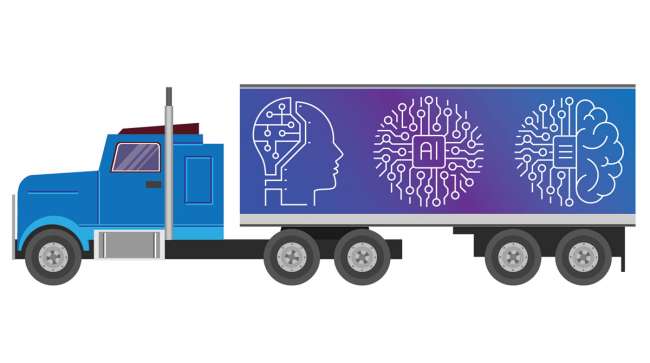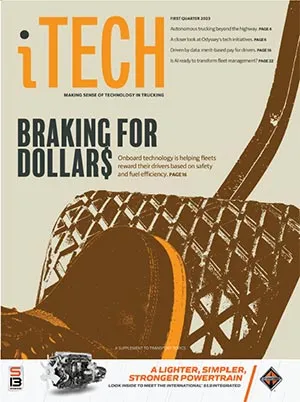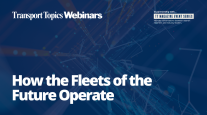Tackling AI Fleet Management

[Find the latest in trucking technology: Explore this quarter's issue of iTECH]
New artificial intelligence capabilities promising automated, 24/7 monitoring of trucking fleets and vehicle maintenance are getting a mixed reaction from trucking leaders.
Some are all in. But others — even if somewhat impressed — are taking more of a wait-and-see approach.
Bill Bliem, senior vice president of fleet services at NFI, is among those who have seen real gains from AI-powered fleet maintenance software.
“Through the use of AI, our goal is to provide our teams with more precise and prescriptive information to enhance the diagnosis process in our shops,” he said. “We want to provide our decision-makers with information and tools that ultimately lead to more uptime and fewer breakdowns.”
Andrew Erin, vice president of technology advancement at PGT Trucking, also is enthusiastic.
“Modern telematic systems provide an overwhelming amount of data that no team of humans could reasonably handle,” he said. “But through AI automation and machine learning algorithms, we can strategically align our internal processes to address key target areas.”

Dysart
Others, like Taki Darakos, vice president of vehicle maintenance and fleet services at Pitt Ohio, are hanging back a bit. Darakos said he is impressed with what he has seen, but is not overly thrilled with the price tag. Nor is he looking forward to the digital overhaul required to bring in a comprehensive fleet-monitoring system powered by AI.
“AI vehicle maintenance tracking seems a little expensive right now,” Darakos said.
Plus, “Adding AI vehicle maintenance tracking represents a major integration job.”
Mark Murrell, president of driver training firm CarriersEdge, also counts himself among the wait-and-see crowd.
“AI is a great idea with a ton of potential. But there aren’t many places where it’s mature enough to be relied on yet,” Murrell said. “At some point, it will absolutely be a powerful tool for assisting with fleet management — but it’s not there yet.”
Jon Wildish, senior vice president at Titan Transfer, will be among the hardest to sell on AI fleet management.
Q1 iTECH
►Incentivizing Driver Excellence
►Five Questions for Odyssey Logistics' CIO
►Dysart: Tackling AI Fleet Management
►Clevenger: Broader Horizons for Autonomous Trucks
Explore the Issue!
“AI automation can have advantages in other areas of trucking. But when it comes to dealing directly with drivers, there’s no better alternative than human contact,” Wildish said. “We have all experienced AI automated systems, whether over the phone or on the internet. I have experienced frustration from just that simple interaction. Now try and manage a fleet of drivers with that process, and you can increase that frustration exponentially.”
Despite these varying perspectives from trucking executives, the makers of AI-powered fleet management systems are soldiering on, relentlessly making new advancements in their software as AI increasingly pervades virtually every facet of computing.
Fortunately, virtually all of the new AI monitoring systems build on the Internet of Things technology that many truckers have been using for years now to remotely track trucks and drivers.
The result: These next-generation AI systems continually monitor and analyze all the data those IoT sensors bring in 24/7, enabling users to respond with automated decisions and solutions around the clock.
Specific benefits that AI fleet management software is promising to trucking companies include:
- Predictive maintenance: Given IoT’s ability to monitor a truck or car down to the granular level — including tire pressure, fuel levels, engine performance as well as the performance of every other system on the vehicle — the addition of AI makes predictive maintenance for each of those vehicles a no-brainer.
With AI, the fleet manager can automatically monitor the performance of each vehicle against benchmark standards on the expected life of a part on that vehicle — and automatically schedule routine maintenance when the life of that part is expected to expire.
That automated analysis and automated problem-solving eliminates a great deal of the guesswork traditionally associated with vehicle maintenance. Plus, the approach offers the fleet manager the ability to reap the benefits of securing full use of a part during its expected life — rather than replacing a part early for fear that it may be getting old.
By spotlighting a part or system that appears to be failing earlier than expected, the AI-powered fleet maintenance system can immediately alert the driver, help schedule maintenance performed at the convenience of both the driver and the enterprise, and make the fleet manager look awfully good at preventing costly breakdowns.
“By ensuring that our equipment is functioning properly on a regular basis, we can limit the risk of large, costly repairs and extended downtime,” PGT’s Erin said. “Last year, PGT partnered with Penske Truck Leasing for our comprehensive maintenance solutions, giving our drivers access to over 850 shops across the U.S. and enhancing our preventive maintenance capabilities. Penske reviews and monitors the data on our trucks, alerts us of any potential issues and proactively repairs the unit before there is a major service issue over the road.”
Yet another advantage of AI for the fleet manager is the system’s ability to ferret out a vehicle part or vehicle system that is performing poorly earlier than anticipated.
While some industry leaders support this type of AI, CarriersEdge’s Murrell is not among them.
“In practice, it’s likely creating as much work as it saves. Until the AI can accurately and reliably report on what’s happening, the flood of false positives will outweigh the benefits of automated reporting,” he said. “Over time, all the systems will get smarter and they will eventually get to the point where the benefits outweigh the effort of managing. But the industry doesn’t appear to be there yet.”
- Automatic breakdown management: Instead of relying on a driver to make pick-up and repair arrangements for a vehicle that suddenly breaks down en route, AI-powered IoT fleet management enables a computer system to automatically inform a repair partner in the area that a vehicle is down and it needs a tow, pronto.
- Auto-rerouting triggered by unexpected road conditions: By monitoring information about conditions on the route ahead, AI-powered fleet management also has the ability to auto-suggest alternative routes should a planned route for a driver offer sudden slowdowns due to accidents, bad weather or other emergencies that suddenly render a road unnavigable.
- Monitoring driving habits: With AI, fleet management systems can evaluate a driver’s habits and techniques in real time and suggest changes when needed. Those could be as simple as suggesting a quicker route that could be used or reminders to ensure a vehicle is brought in for scheduled maintenance.
Pitt Ohio’s Darakos said he has successfully used AI-powered cameras to help monitor drivers who miss stop signs, roll through stoplights or engage in other risky driving behaviors. The monitoring is completely automated, in that any unsafe move by a driver is flagged by the AI as an anomaly, which triggers an alert to company staff who monitor driver performance.
Cognizant that drivers could see such monitoring as an unnecessary nag, Darakos indicated that Pitt Ohio uses the monitoring system judiciously. The AI, for example, only triggers a call from a human coach when drivers are involved in serious infractions or are repeatedly and excessively exhibiting poor driving habits. Plus, the system goes out of its way to recognize drivers with extremely safe driving habits.
Currently, the AI camera only faces toward the road — although the two-way system is capable of monitoring the driver’s face and body as well if fleets choose to deploy that capability. Darakos said Pitt Ohio has decided to hold off on direct camera monitoring of the actual driver until drivers are ready for that kind of major, cultural change.
Titan Transfer’s Wildish is also extremely upbeat on AI-powered cameras in trucks. “I believe this technology has the potential to be a game changer for drivers — especially for newer drivers in the industry,” he said. “Done properly, AI technology can improve safe driving behavior with in-cab audible coaching for both positive and negative scenarios.”
PGT has deployed dash cameras in its fleet to monitor safety risks, such as poor following distance and distracted driving, and proactively coach its drivers.
“The AI is capable of discerning if the unsafe condition was caused by our driver or by an outside force, like a car who quickly cuts in front of our truck,” Erin said. This technology allows our human driver coaches to focus on truly coachable events instead of spending time filtering out false-positive alerts.”
No matter your current take on AI-powered fleet management, it at least is worth monitoring in the short term.
Joe Dysart is an internet speaker and business consultant based in Manhattan. Voice: (631) 438-1142. Email: joe@gurutechalert.com
Want more news? Listen to today's daily briefing below or go here for more info:





